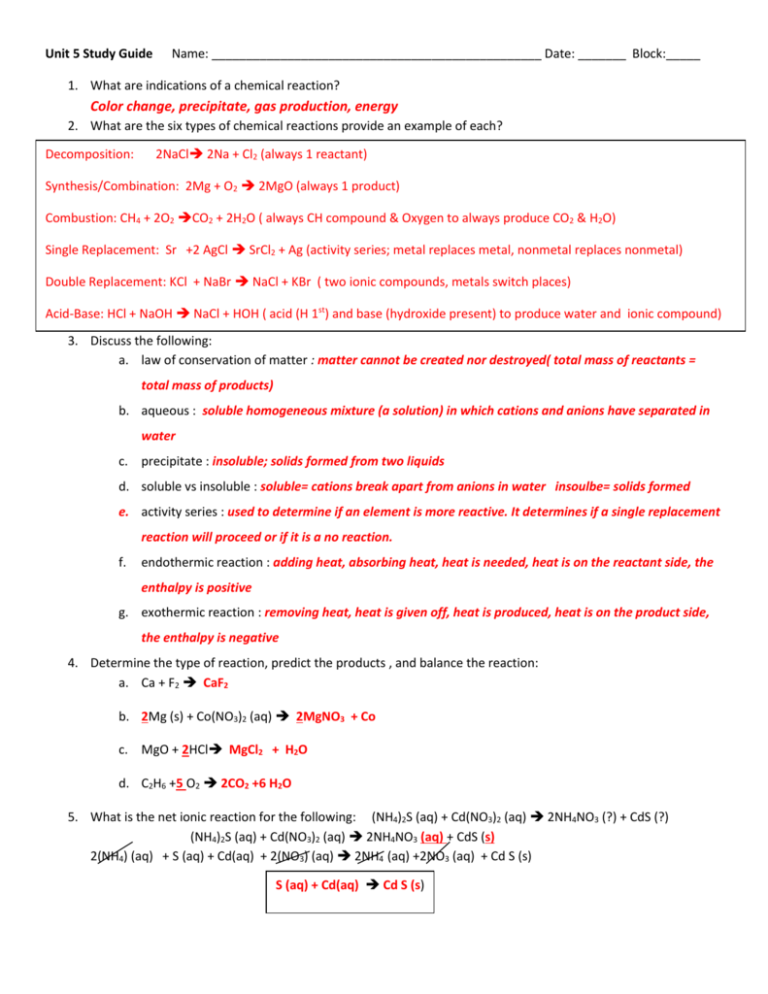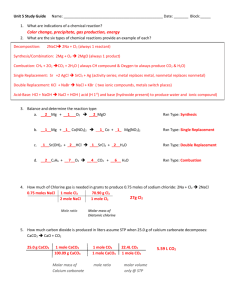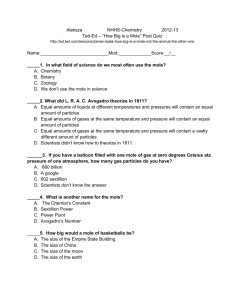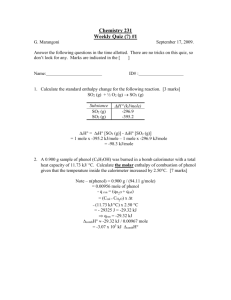Unit 5 Study Guide Name: Date: ______ Block:_____ What are
advertisement

Unit 5 Study Guide Name: ________________________________________________ Date: _______ Block:_____ 1. What are indications of a chemical reaction? Color change, precipitate, gas production, energy 2. What are the six types of chemical reactions provide an example of each? Decomposition: 2NaCl 2Na + Cl2 (always 1 reactant) Synthesis/Combination: 2Mg + O2 2MgO (always 1 product) Combustion: CH4 + 2O2 CO2 + 2H2O ( always CH compound & Oxygen to always produce CO2 & H2O) Single Replacement: Sr +2 AgCl SrCl2 + Ag (activity series; metal replaces metal, nonmetal replaces nonmetal) Double Replacement: KCl + NaBr NaCl + KBr ( two ionic compounds, metals switch places) Acid-Base: HCl + NaOH NaCl + HOH ( acid (H 1st) and base (hydroxide present) to produce water and ionic compound) 3. Discuss the following: a. law of conservation of matter : matter cannot be created nor destroyed( total mass of reactants = total mass of products) b. aqueous : soluble homogeneous mixture (a solution) in which cations and anions have separated in water c. precipitate : insoluble; solids formed from two liquids d. soluble vs insoluble : soluble= cations break apart from anions in water insoulbe= solids formed e. activity series : used to determine if an element is more reactive. It determines if a single replacement reaction will proceed or if it is a no reaction. f. endothermic reaction : adding heat, absorbing heat, heat is needed, heat is on the reactant side, the enthalpy is positive g. exothermic reaction : removing heat, heat is given off, heat is produced, heat is on the product side, the enthalpy is negative 4. Determine the type of reaction, predict the products , and balance the reaction: a. Ca + F2 CaF2 b. 2Mg (s) + Co(NO3)2 (aq) 2MgNO3 + Co c. MgO + 2HCl MgCl2 + H2O d. C2H6 +5 O2 2CO2 +6 H2O 5. What is the net ionic reaction for the following: (NH4)2S (aq) + Cd(NO3)2 (aq) 2NH4NO3 (?) + CdS (?) (NH4)2S (aq) + Cd(NO3)2 (aq) 2NH4NO3 (aq) + CdS (s) 2(NH4) (aq) + S (aq) + Cd(aq) + 2(NO3) (aq) 2NH4 (aq) +2NO3 (aq) + Cd S (s) S (aq) + Cd(aq) Cd S (s) 6. How much of Chlorine gas is needed in grams to produce 0.75 moles of sodium chloride: 2Na + Cl2 NaCl 0.75 moles NaCl 1 mole Cl2 70.90 g Cl2 53.18 g Cl2 1 mole NaCl 1 mole Cl2 Mole ratio Molar mass of Diatomic chlorine 7. How much carbon dioxide is produced in liters assume STP when 25.0 g of calcium carbonate decomposes: CaCO3 CaO + CO2 25.0 g CaCO3 1 mole CaCO3 100.09 g CaCO3 Molar mass of Calcium carbonate 1 mole CO2 1 mole CaCO3 22.4L CO2 1 mole CO2 mole ratio 5.59 L CO2 molar volume only @ STP 8. What is the max amount of aluminum chloride produced in grams when 4.25 x 1022 atoms of aluminum react with 18.23 grams of chlorine gas? What is the limiting reactant? What is the excess reactant? What is the percent yield if 17.48 g of aluminum chloride is produced in lab? 2Al + 3Cl2 2AlCl3 4.25 x 1022 atoms Al 18.23 g Cl2 1 mole Al 6.02 x 1023 atoms Al 1 mole Cl2 70.90g Cl2 2 mole AlCl3 2 mole Al 2 mole AlCl3 133.33g AlCl3 3 mole Cl2 1 mole AlCl3 133.33 g AlCl3 1 mole AlCl3 = 9.41 g AlCl3 = 22.85 g AlCl3 Limiting reactant: Aluminum Excess reactant: Chlorine Actual Theoretical 17.48 g 9.41 g = 185.76 % 9. How much energy is associated with this reaction when there is 4.00 grams of hydrogen reacts with excess carbon? C (s) + 2H2 (g) CH4 (g) + 74.3 kJ 4.00 g H2 1 mole H2 -74.3 kJ = -73.56 kJ 2.02 g H2 2 mole H2 10. If 67.4 kJ is used in the reaction between hydrogen and carbon dioxide, how many liters of carbon monoxide can be produced at STP? H2 (g) + CO2 (g) + 11 kJ H2O (g) + CO(g) 67.4 kJ 1 mole CO 22.4L CO 11 kJ 1 mole CO = 137.25 L CO







